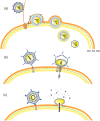Half a Century of Research on Membrane-Containing Bacteriophages: Bringing New Concepts to Modern Virology
- PMID: 30669250
- PMCID: PMC6356626
- DOI: 10.3390/v11010076
Half a Century of Research on Membrane-Containing Bacteriophages: Bringing New Concepts to Modern Virology
Abstract
Half a century of research on membrane-containing phages has had a major impact on virology, providing new insights into virus diversity, evolution and ecological importance. The recent revolutionary technical advances in imaging, sequencing and lipid analysis have significantly boosted the depth and volume of knowledge on these viruses. This has resulted in new concepts of virus assembly, understanding of virion stability and dynamics, and the description of novel processes for viral genome packaging and membrane-driven genome delivery to the host. The detailed analyses of such processes have given novel insights into DNA transport across the protein-rich lipid bilayer and the transformation of spherical membrane structures into tubular nanotubes, resulting in the description of unexpectedly dynamic functions of the membrane structures. Membrane-containing phages have provided a framework for understanding virus evolution. The original observation on membrane-containing bacteriophage PRD1 and human pathogenic adenovirus has been fundamental in delineating the concept of "viral lineages", postulating that the fold of the major capsid protein can be used as an evolutionary fingerprint to trace long-distance evolutionary relationships that are unrecognizable from the primary sequences. This has brought the early evolutionary paths of certain eukaryotic, bacterial, and archaeal viruses together, and potentially enables the reorganization of the nearly immeasurable virus population (~1 × 1031) on Earth into a reasonably low number of groups representing different architectural principles. In addition, the research on membrane-containing phages can support the development of novel tools and strategies for human therapy and crop protection.
Keywords: Corticoviridae; Cystoviridae; Plasmaviridae; Tectiviridae; lipid-containing bacteriophage; virus evolution; virus–host interaction.
Conflict of interest statement
The authors declare no conflict of interest. The funders had no role in the design of the study; in the collection, analyses, or interpretation of data; in the writing of the manuscript, or in the decision to publish the results.
Figures

References
-
- Atanasova N.S., Senčilo A., Pietilä M.K., Roine E., Oksanen H.M., Bamford D.H. Comparison of lipid-containing bacterial and archaeal viruses. Adv. Virus Res. 2015;92:1–61. - PubMed
Publication types
MeSH terms
Substances
Grants and funding
LinkOut - more resources
Full Text Sources

